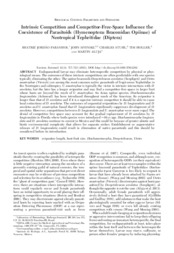Intrinsic competition and competitor-free-space influence the coexistence of parasitoids (Hymenoptera: Braconidae: Opiinae) of neotropical Tephritidae (Diptera).
Intrinsic competition and competitor-free-space influence the coexistence of parasitoids (Hymenoptera: Braconidae: Opiinae) of neotropical Tephritidae (Diptera).
Author(s): PARANHOS, B. A. J.; SIVINSKI, O.; STUHL, C.; HOLLER, T.; ALUJA, M.
Summary: Endoparasitoid larvae may eliminate heterospeciÞc competitors by physical or physiological means. The outcomes of these intrinsic competitions are often predictable with one species typically eliminating the other. The opiine braconids Doryctobracon areolatus (Szepligeti) and Utetes anastrephae (Viereck) are among the most common native parasitoids of frugivorous Tephritidae in the Neotropics and subtropics. U. anastrephae is typically the victor in intrinsic interactions with D. areolatus, but the later has a longer ovipositor and may Þnd a competitor-free-space in larger fruit whose hosts are beyond the reach of U. anastrephae. An Asian opiine species, Diachasmimorpha longicaudata (Ashmead) has been introduced throughout much of the Americas. Its ovipositor is longer than that of D. areolatus and if it is a superior intrinsic competitor it should be able to cause local extinctions of D. areolatus. The outcomes of sequential ovipositions by D. longicaudata and D. areolatus and U. anastrephae found that D. longicaudata signiÞcantly suppresses development of D. areolatus. However, competitions between D. longicaudata and U. anastrephae were more equal. The denial of competitor free space may account for the gradual replacement of D. areolatus by D. longicaudata in Florida where both species were introduced 40 yr ago. Diachasmimorpha longicaudata and D. areolatus continue to coexist in Mexico and this could be because of greater abiotic and biotic environmental complexity that allows for separate niches. Establishment or augmentative releases of D. longicaudata could result in elimination of native parasitoids and this should be considered before its introduction.
Publication year: 2013
Types of publication: Journal article
Unit: Embrapa Semi-arid Region
Keywords: Controle Biológico, Diachasmimorpha, Doryctobracon, Entomologia, Entomology, Inseto
Observation
Some of Embrapa's publications are published as ePub files. To read them, use or download one of the following free software options to your computer or mobile device. Android: Google Play Books; IOS: iBooks; Windows and Linux: Calibre.
Access other publications
Access the Agricultural Research Database (BDPA) to consult Embrapa's full library collection and records.
Visit Embrapa Bookstore to purchase books and other publications sold by Embrapa.

